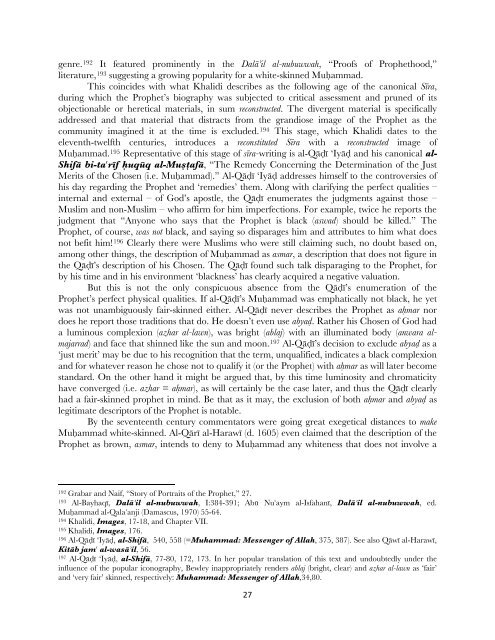“Anyone who says that the Prophet is black should be killed”: The ...
“Anyone who says that the Prophet is black should be killed”: The ...
“Anyone who says that the Prophet is black should be killed”: The ...
Create successful ePaper yourself
Turn your PDF publications into a flip-book with our unique Google optimized e-Paper software.
genre. 192 It featured prominently in <strong>the</strong> Dal§"il al-nubuwwah, “Proofs of <strong>Prophet</strong>hood,”<br />
literature, 193 suggesting a growing popularity for a white-skinned MuÈammad.<br />
Th<strong>is</strong> coincides with what Khalidi descri<strong>be</strong>s as <strong>the</strong> following age of <strong>the</strong> canonical SÊra,<br />
during which <strong>the</strong> <strong>Prophet</strong>’s biography was subjected to critical assessment and pruned of its<br />
objectionable or heretical materials, in sum reconstructed. <strong>The</strong> divergent material <strong>is</strong> specifically<br />
addressed and <strong>that</strong> material <strong>that</strong> d<strong>is</strong>tracts from <strong>the</strong> grandiose image of <strong>the</strong> <strong>Prophet</strong> as <strong>the</strong><br />
community imagined it at <strong>the</strong> time <strong>is</strong> excluded. 194 Th<strong>is</strong> stage, which Khalidi dates to <strong>the</strong><br />
eleventh-twelfth centuries, introduces a reconstituted SÊra with a reconstructed image of<br />
MuÈammad. 195 Representative of th<strong>is</strong> stage of sÊra-writing <strong>is</strong> al-Q§∙Ê ‘Iy§∙ and h<strong>is</strong> canonical al-<br />
Shif§ bi-ta#rÊf Èuqåq al-Mußãaf§, “<strong>The</strong> Remedy Concerning <strong>the</strong> Determination of <strong>the</strong> Just<br />
Merits of <strong>the</strong> Chosen (i.e. MuÈammad).” Al-Q§∙Ê ‘Iy§∙ addresses himself to <strong>the</strong> controversies of<br />
h<strong>is</strong> day regarding <strong>the</strong> <strong>Prophet</strong> and ‘remedies’ <strong>the</strong>m. Along with clarifying <strong>the</strong> perfect qualities –<br />
internal and external – of God’s apostle, <strong>the</strong> Q§∙Ê enumerates <strong>the</strong> judgments against those –<br />
Muslim and non-Muslim – <strong>who</strong> affirm for him imperfections. For example, twice he reports <strong>the</strong><br />
judgment <strong>that</strong> <strong>“Anyone</strong> <strong>who</strong> <strong>says</strong> <strong>that</strong> <strong>the</strong> <strong>Prophet</strong> <strong>is</strong> <strong>black</strong> (aswad) <strong>should</strong> <strong>be</strong> killed.” <strong>The</strong><br />
<strong>Prophet</strong>, of course, was not <strong>black</strong>, and saying so d<strong>is</strong>parages him and attributes to him what does<br />
not <strong>be</strong>fit him! 196 Clearly <strong>the</strong>re were Muslims <strong>who</strong> were still claiming such, no doubt based on,<br />
among o<strong>the</strong>r things, <strong>the</strong> description of MuÈammad as asmar, a description <strong>that</strong> does not figure in<br />
<strong>the</strong> Q§∙Ê’s description of h<strong>is</strong> Chosen. <strong>The</strong> Q§∙Ê found such talk d<strong>is</strong>paraging to <strong>the</strong> <strong>Prophet</strong>, for<br />
by h<strong>is</strong> time and in h<strong>is</strong> environment ‘<strong>black</strong>ness’ has clearly acquired a negative valuation.<br />
But th<strong>is</strong> <strong>is</strong> not <strong>the</strong> only conspicuous absence from <strong>the</strong> Q§∙Ê’s enumeration of <strong>the</strong><br />
<strong>Prophet</strong>’s perfect physical qualities. If al-Q§∙Ê’s MuÈammad was emphatically not <strong>black</strong>, he yet<br />
was not unambiguously fair-skinned ei<strong>the</strong>r. Al-Q§∙Ê never descri<strong>be</strong>s <strong>the</strong> <strong>Prophet</strong> as aÈmar nor<br />
does he report those traditions <strong>that</strong> do. He doesn’t even use abya∙. Ra<strong>the</strong>r h<strong>is</strong> Chosen of God had<br />
a luminous complexion (azhar al-lawn), was bright (ablaj) with an illuminated body (anwara almajarrad)<br />
and face <strong>that</strong> shinned like <strong>the</strong> sun and moon. 197 Al-Q§∙Ê’s dec<strong>is</strong>ion to exclude abya∙ as a<br />
‘just merit’ may <strong>be</strong> due to h<strong>is</strong> recognition <strong>that</strong> <strong>the</strong> term, unqualified, indicates a <strong>black</strong> complexion<br />
and for whatever reason he chose not to qualify it (or <strong>the</strong> <strong>Prophet</strong>) with aÈmar as will later <strong>be</strong>come<br />
standard. On <strong>the</strong> o<strong>the</strong>r hand it might <strong>be</strong> argued <strong>that</strong>, by th<strong>is</strong> time luminosity and chromaticity<br />
have converged (i.e. azhar = aÈmar), as will certainly <strong>be</strong> <strong>the</strong> case later, and thus <strong>the</strong> Q§∙Ê clearly<br />
had a fair-skinned prophet in mind. Be <strong>that</strong> as it may, <strong>the</strong> exclusion of both aÈmar and abya∙ as<br />
legitimate descriptors of <strong>the</strong> <strong>Prophet</strong> <strong>is</strong> notable.<br />
By <strong>the</strong> seventeenth century commentators were going great exegetical d<strong>is</strong>tances to make<br />
MuÈammad white-skinned. Al-Q§rÊ al-HarawÊ (d. 1605) even claimed <strong>that</strong> <strong>the</strong> description of <strong>the</strong><br />
<strong>Prophet</strong> as brown, asmar, intends to deny to MuÈammad any whiteness <strong>that</strong> does not involve a<br />
192 Grabar and Naif, “Story of Portraits of <strong>the</strong> <strong>Prophet</strong>,” 27.<br />
193 Al-BayhaqÊ, Dal§"il al-nubuwwah, I:384-391; Abå Nu#aym al-IsfahanÊ, Dal§"il al-nubuwwah, ed.<br />
MuÈammad al-Qala"anji (Damascus, 1970) 55-64.<br />
194 Khalidi, Images, 17-18, and Chapter VII.<br />
195 Khalidi, Images, 176.<br />
196 Al-Q§∙Ê ‘Iy§∙, al-Shif§, 540, 558 (=Muhammad: Messenger of Allah, 375, 387). See also Q§wÊ al-HarawÊ,<br />
Kit§b jam# al-was§"il, 56.<br />
197 Al-Q§∙Ê ‘Iy§∙, al-Shif§, 77-80, 172, 173. In her popular translation of th<strong>is</strong> text and undoubtedly under <strong>the</strong><br />
influence of <strong>the</strong> popular iconography, Bewley inappropriately renders ablaj (bright, clear) and azhar al-lawn as ‘fair’<br />
and ‘very fair’ skinned, respectively: Muhammad: Messenger of Allah,34,80.<br />
27
















